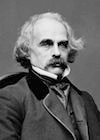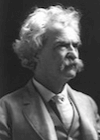
Ernest Hemingway (1899 - 1961) was an iconic American journalist and author, known for his brief and straightforward style of writing and for the gusto with which he lived his life. He participated in World War I as an ambulance driver until he was injured; then again during World War II. He served as a war correspondent during the Spanish Civil War; survived car accidents and plane crashes as well as mishaps on hunting and fishing expeditions. And if that wasn't enough danger for one man, he crowned it with an exclamation point by marrying four times; Hadley Richardson (1921-1927), Pauline Pfeiffer (1927-1940), Martha Gellhorn (1940-1945) and Mary Welsh (1946-1961). His experiences in war led him to abandon abstract language as empty, in favor of his hallmark writing style, in which he savored simplified and concrete actions. As if it were so easy: "There is nothing to writing. All you do is sit down at a typewriter and bleed."
 He is best known for his novels; most readers are familiar with The Sun Also Rises (1926), A Farewell to Arms (1929), For Whom the Bell Tolls (1940), and The Old Man and the Sea (1952). Though there were strong critics of his work -- particularly feminist-minded critics that were highly critical of his generally unflattering portrayal of female characters -- he received the Pulitzer Prize in 1953 for The Old Man and the Sea and the Nobel Prize in Literature in 1954. We feature Hemingway in our collection of Pulitzer Prize Winners.
He is best known for his novels; most readers are familiar with The Sun Also Rises (1926), A Farewell to Arms (1929), For Whom the Bell Tolls (1940), and The Old Man and the Sea (1952). Though there were strong critics of his work -- particularly feminist-minded critics that were highly critical of his generally unflattering portrayal of female characters -- he received the Pulitzer Prize in 1953 for The Old Man and the Sea and the Nobel Prize in Literature in 1954. We feature Hemingway in our collection of Pulitzer Prize Winners.

Visit American History for other important figures and writing which helped shape the country.
"All modern American literature comes from one book by Mark Twain called Huckleberry Finn." There was nothing before. There has been nothing as good since.”









